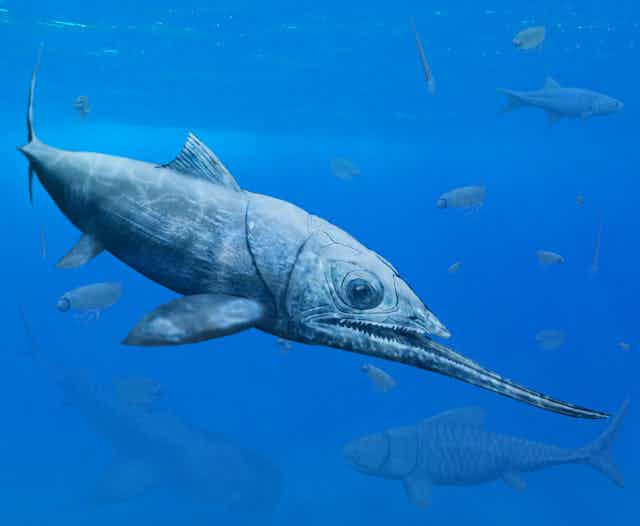Vertebrates are defined as all animals that possess a vertebral column, or backbone. Most living vertebrates also possess jaws, teeth and paired fins or limbs.
Fossils of the earliest vertebrates help us understand not only how these features originated, but also how they evolved and diversified over time.
Our study, published in Royal Society Open Science, examines 365-million-year-old fossils of a fish with the world’s longest underbite, called Alienacanthus malkowskii. These fossils demonstrate the diversity of jawed vertebrates early on during their evolution.
Alienacanthus is a member of an extinct group of fish called placoderms, which are some of the first jawed vertebrates. They are armoured fish of various shapes and sizes and are essential to understanding the evolution of vertebrates and their features, particularly jaws and teeth.
Together, placoderm jaws and teeth hold evidence of feeding strategies and diets, giving us insights into what and how some of our fishy ancestors ate.
From spine to jaw
In 1957, Polish paleontologist Julian Kulczycki described fossil fishes from the Polish Holy Cross mountains. Among these finds were two partially broken long thin bones which he thought were some weird-looking fin spines from a fish. The odd shape of the so-called spines gave the animal its name, Alienacanthus.
In the late 1990s to early 2000s, members of our research team came across some Moroccan specimens in the collections of the Muséum national d’Histoire naturelle in Paris that included the same bony elements. The team later encountered more specimens from Poland and Morocco, which we identified as belonging to a placoderm.

Alienacanthus had a massive, rounded head with a pointy snout and large eyes. What Kulczycki had identified as spines turned out to be the lower jaws, which extended way past the closing of the mouth, unlike the upper jaws. The teeth were sharp, slightly curved towards the back to trap live prey, and the teeth continued past the closing of the mouth.
Unlike in other placoderms, the upper jaws of Alienacanthus were capable of a slight movement independently of the skull, helping to accommodate the lower jaw.
Most extreme case
The extended lower jaw of Alienacanthus, twice as long as the skull, is unique among placoderms and extremely rare in other living and fossil groups. In most animals, jaw protrusion is seen in the upper jaw, like in the swordfish, or both upper and lower jaws like ichthyosaurs or gharials.
Among living species, only a tiny fish called the halfbeak shows an elongated lower jaw. The halfbeak measures just five to 10 cm in length, while Alienacanthus’ head and jaws alone reach 80 cm. The relative length of the lower jaw is also 20 per cent greater than in the halfbeak.

Alienacanthus also holds the title of the oldest case of lower jaw elongation. The previous record belonged to the 310-million-year-old shark Ornithoprion.
The Age of fishes
Alienacanthus and relatives lived during the Devonian period (358 to 419 million years ago), also referred to by paleontologists as the Age of fishes. During this time, a variety of fish groups ruled the oceans, including sharks, bony fishes, jawless fishes and placoderms, which together illustrated a wide range of body, head and jaw shapes.
Read more: Ancient fishes kept their young in a nursery
Alienacanthus stretches that diversity to the limit with such a unique look. Fifteen million years after this animal’s occurrence, placoderms met their demise.
The evolution of more complex jaws allowed for a wider range of feeding and hunting methods. The oldest placoderms favoured a fast-closing mouth for catching prey. But some placoderms started feeding on durophagous animals, with hard shells and exoskeletons, and others may have been filter-feeders.
Alienacanthus used its sharp teeth to catch and trap live prey, possibly using its elongated jaw to confuse or injure its future meal, as seen in swordfish and some ichthyosaurs.
Learning more
The further back in time we go, the more our planet’s continents looked different. During the Late Devonian period, when Alienacanthus lived, Poland was situated on the northeastern coast and Morocco on the southern coast of a vast ocean. The presence of the same species on both ends shows that migration occurred in that ocean at that time, despite sea level fluctuation.
Alienacanthus comprises just one of numerous recent finds in Poland and Morocco from the Late Devonian period. Such discoveries illustrate the remaining high potential for deposits of this age to reveal critical insights about early vertebrates.

